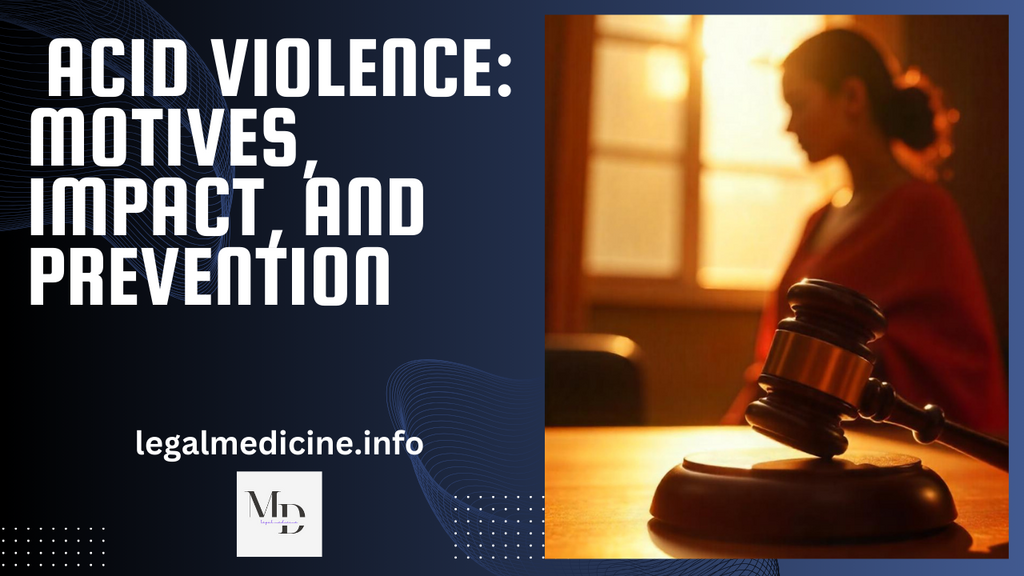Acid Violence: Motives, Impact, and Prevention

Acid violence remains one of the most brutal forms of assault, leaving victims with lifelong physical and emotional scars. While the number of acid attacks has declined over the years, the issue persists, often fueled by personal vendettas, property disputes, and societal failures. This article explores the motives behind acid violence, its long-term effects, and preventive measures.
Motives Behind Acid Violence
Acid attacks often stem from personal conflicts and power dynamics. Based on recent reports and data, the primary reasons for acid violence include:
1. Property-Related Disputes
- Many acid violence cases involve land and property disputes.
- Between 2006 and 2011, nearly 50% of acid attacks resulted from land disagreements.
- The numbers gradually decreased over the years, dropping to 25% in 2015 and below 20% between 2017 and 2022.
- In 2022, five cases involved acid attacks related to property conflicts.
2. Dowry-Related Violence
- Dowry demands continue to cause acid attacks, with women becoming victims of their husbands or in-laws.
- In 2022, four cases involved husbands attacking their wives over dowry disputes.
3. Rejection of Proposals
- Women who refuse advances or illicit proposals from neighbors or acquaintances often become targets.
- These cases reflect a deeply rooted patriarchal mindset that seeks to punish women for exercising autonomy.
4. Revenge by Ex-Partners
- Former lovers and spouses commit acid attacks out of jealousy, rejection, or a sense of entitlement over the victim.
- One case in 2022 involved an ex-husband resorting to acid violence.
5. Family Feuds and Personal Revenge
- Relatives, acquaintances, and even family friends have used acid to settle personal disputes.
- In 2022, five such incidents occurred, showing that even close circles can turn violent.
Acid Violence Statistics: A Look at the Numbers

The Acid Survivors Foundation (ASF) has tracked acid violence cases since 1999. Their data provides crucial insights into trends over the years:
- Between 1999 and 2022, acid attacks affected 3,870 people.
- The highest number of cases occurred in 2002, with 496 victims.
- Since 2003, cases have gradually declined.
- Annual victim statistics:
- 2018: 22 cases
- 2019: 21 cases
- 2020: 22 cases
- 2021: 19 cases
- 2022: 27 cases
- Women account for approximately 59% of acid attack victims, highlighting gender-based violence as a significant issue.
The Devastating Impact of Acid Attacks

Acid attacks cause severe physical damage and lead to emotional and social suffering.
1. Medical Consequences
- Acid burns penetrate deep into the skin, causing permanent disfigurement.
- Unlike burns from fire or hot water, acid damage extends beyond the surface layers of the skin.
- According to Dr. Tanvir Ahmed, an associate professor at Sheikh Hasina National Burn and Plastic Surgery Institute, treatment can take 5 to 6 years, and complete restoration is often impossible.
2. Psychological Trauma
- Survivors often suffer from depression, anxiety, and post-traumatic stress disorder (PTSD).
- Many victims experience social ostracization, losing their confidence and ability to lead a normal life.
3. Economic and Social Consequences
- Many survivors lose employment opportunities due to facial disfigurement.
- Social stigma prevents victims from reintegrating into society, leading to isolation.
Challenges in Preventing Acid Violence
Despite legal restrictions and declining cases, challenges remain in completely eradicating acid violence.
1. Weak Monitoring of Acid Sales
- The easy availability of acid in markets makes it a preferred weapon for attackers.
- A lack of strict regulations on acid sales contributes to continued violence.
2. Inadequate Legal Enforcement
- Many attackers escape punishment due to lengthy trials and poor legal execution.
- Victims often lack access to legal assistance, allowing perpetrators to walk free.
3. Declining Awareness Campaigns
- According to ASF’s Executive Director, Sarder Jahangir Hossain, awareness efforts have weakened.
- Policymakers, law enforcement, and media should work together to sustain educational campaigns about acid violence.
Preventive Measures: How to Combat Acid Violence

A multi-faceted approach is necessary to combat acid violence effectively.
1. Stricter Regulations on Acid Sales
- Governments should enforce stringent laws on the sale and distribution of acid.
- Only licensed buyers should be allowed to purchase acid for industrial and medical use.
2. Harsher Punishments for Perpetrators
- Fast-track courts should be established to ensure speedy trials.
- Severe penalties, including life imprisonment, should be enforced to deter potential offenders.
3. Psychological and Medical Support for Survivors
- Government and NGOs should provide free reconstructive surgeries and mental health counseling.
- Job training programs should be introduced to help survivors regain independence.
4. Community Awareness and Education
- Schools and workplaces should conduct awareness programs on acid violence and gender-based violence.
- Media should play a proactive role in highlighting cases and promoting preventive measures.
Frequently Asked Questions (FAQs)
Q1: Why do acid attacks happen?
Acid attacks often stem from personal revenge, property disputes, rejection of marriage proposals, dowry issues, and domestic conflicts.
Q2: Are acid attacks decreasing worldwide?
Yes, in many countries, acid attack cases have declined due to stricter laws and awareness programs, but they still persist in some regions.
Q3: What laws exist against acid violence?
Many countries have implemented laws restricting acid sales and enforcing harsh penalties for attackers. However, legal enforcement remains a challenge.
Q4: How can acid attack survivors be supported?
Survivors need medical aid, reconstructive surgery, psychological counseling, legal assistance, and financial support for rehabilitation.
Q5: How can I help prevent acid violence?
Raising awareness, supporting strict regulations on acid sales, helping survivors, and advocating for stronger legal enforcement can all contribute to prevention.
Conclusion
While acid violence has declined over the years, it remains a horrifying crime affecting countless lives. Strengthening laws, raising awareness, and providing medical and psychological support are crucial to eradicating this inhumane act. Society must stand together to protect victims and prevent future attacks, ensuring that justice is served and survivors receive the support they deserve.
Acid Survivors Foundation (ASF) – Provides support, rehabilitation, and advocacy for acid attack survivors.
https://acidsurvivors.org
United Nations Women – Ending Gender-Based Violence – Resources on policies and global efforts to combat acid attacks and violence against women.
https://www.unwomen.org/en/what-we-do/ending-violence-against-women
